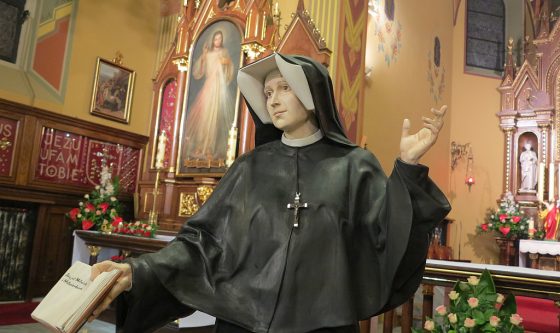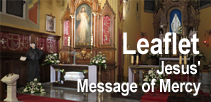The school of spirituality, as indicates the name itself, signifies a style of Christian life and system of his forming in which all the elements of spirituality such as: the image of God, prayer, asceticism, ascetical practises, interpersonal relationships… are strictly related to each other. Each school of spirituality has its own founder, doctrine and disciples, who live according to its rules. Schools basicly differ among each other in three elements: model of sanctity, suggested means to its achievement and tips regarding the interior life. To the great schools of Christian spirituality belong, among others, the Benedictines, Franciscans, Dominicans, Carmelites or Jesuits. The school of St. Faustina, which grows from her charism and mystical experience, joined the group in our times.
The school of St. Faustina’s spirituality is rooted in the mystery of Divine Mercy which lies in its foundation and in the centre itself, and is the binder of all the elements of the interior life. It forms the image of God, sacramental life, asceticism, namely, everything which compounds the reality in the relation between man and God. Hence the school of St. Faustina’s spirituality is marked out and characterised by the coming to know the mystery of Divine Mercy and contemplating it in everyday life and the ensuing attitude of entrustment to God and merciful love toward neighbour. The image of this school is completed by the following features: having love for the Church, Eucharist and devotion to Our Lady. These elements, which also appear in other schools of spiritualities, in the school of St. Faustina have a typical “aspect” of mercy.
The foundress of this school – Saint Faustina – was directly formed by Jesus Himself. He was her Master, He taught her through different mystical experiences and words, formed her spirituality to show through it a model of Christian perfection completely founded on the mystery of the Divine Mercy. The school of St. Faustina is profoundly evangelical because it revokes to the foundation of Christianity (the attitude of trust in God and mercy towards neighbours) and at the same time is universal because it is reserved and accessible for every man without consideration of the type of vocation, social conditions or others. The contemporary apostles of Divine Mercy, who carry the gift of the message about merciful love of God for every human being, form their spiritual life in the school.
As we begin to study the fundamental characteristics of Sister Faustina’s spirituality, we must first specify the concept of spirituality itself. The definition found in the dictionary states that “spirituality is the systematic and prudent practise of being prayerfully, piously true to the rules of Christian life.” Simply speaking – spirituality encompasses everything that relates to the practise of religion, to that reality in which man meets with God. The description of Christian spirituality takes all the elements of the interior life into consideration and so: prayer, asceticism, the experience of the mysteries of the faith, the liturgy, the ways of imitating Christ, as well as social back- ground and, nowadays, various psychological conditions.
In the history of Christian spirituality, we speak about schools, which deal with specific groups of methods of ascetical practises and methods of prayer that lead to union with God. The schools of spirituality are usually linked to the charisms of religious orders such as: the Benedictines, Dominicans, Franciscans, Carmelites, or Jesuits. Besides the schools, we also find trends in the history of spirituality, which are less closely associated with the doctrine of prayer life and asceticism. The historians of Christian spirituality distinguish the various spiritualities of saints, of given epochs in the history of the Church, and even of nations. Each epoch has its peculiar climate of spiritual life, its own model of holiness, its own way of experiencing the truth of faith, its own asceticism, devotions and prayers.
The history of Christian spirituality relates the great richness and variety of ways of experiencing the mystery of God in the life of man; it describes the host of roads upon which man meets His Creator and Saviour and presents the different methods of prayer and ascesis that lead to union with Him in love and to sharing in His mission. For instance, the Benedictine school of the interior life is based primarily on the liturgy and its careful consideration. And so the motto ora et labora – pray and work – perfectly reflects the lifestyle of the people living this spirituality. The Dominican spirituality accentuates the crucial role of knowledge; that is to say, the power of reason in the interior life and man’s contact with God, whereas the Franciscans emphasise the effort of man’s will which plays a more important role for them than reason on the road of union with God. The Carmelite school focuses on prayer leading to the contemplation of God, on the other hand, Ignatian spirituality concentrates on meditation, working on oneself and cooperating wisely with God in the battle for the Kingdom of God on earth under Christ’s banner.
Today too we can detect a very rich mosaic of different spiritualities in the life of the Church. Among them are the old schools, which developed from the charisms of the Benedictines, Franciscans, Dominicans, Carmelites, and Jesuits, as well as the new spiritualities brought into the life of the Church by new communities and movements.
The spirituality of Sister Faustina holds a very important place in this remarkably rich panorama of spiritualities of the modern Church. Historians will have to go to the figure of this humble Polish nun, the apostle of the Divine Mercy, when they write about the spirituality of the 20th or 21st centuries; since, even today, we can clearly see her influence on the life of faith in our epoch – not only in Poland but throughout the world. In our study of Sister Faustina’s spirituality, we will focus primarily on its fundamental characteristics: coming to know the mystery of Divine Mercy and contemplating it in everyday life; perfecting one’s attitude of trust in God and mercy toward neighbour; having love for the Church and the Eucharist, and devotion to Our Lady.
sr. M. Elisabeth Siepak ISMM
Prepared by sr. M. Diana Kuczek ISMM
















